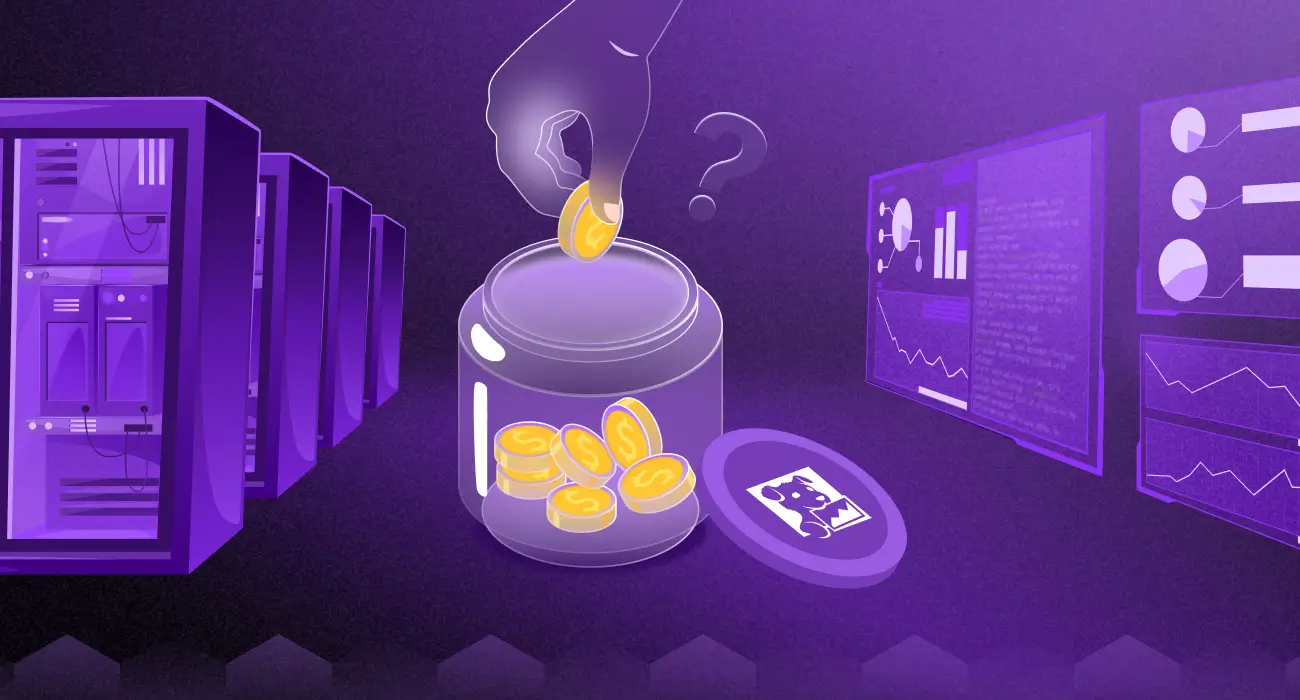Datadog has become one of the most comprehensive observability platforms on the market, but Datadog pricing is also one of the most expensive. Datadog has tiered pricing, hidden add-ons, and a high-watermark billing model, which often leaves teams paying far more than expected.
According to public estimates, many mid-sized companies spend $50,000–$150,000 per year on Datadog for full-stack monitoring, with enterprise deployments easily exceeding $1 million annually once APM, logs, and RUM are included.
Pricing Overview
We’ll break down Datadog’s pricing by feature (logs, APM, infra, RUM, synthetics), and then stack it against Middleware. This newer, transparent observability platform offers similar power at 1/5th the cost.
How on earth do people deal with Datadog’s billing practices?
byu/ycnz insysadmin
“If your Datadog bill is spiraling or you’re exploring alternatives, this side-by-side comparison will help you make an informed decision for 2026.”
Datadog’s Pricing Model (2026)
Datadog has a complicated tiered pricing scheme that may benefit large teams but results in arbitrary billing.
- Billing resets at the start of each month (UTC), regardless of signup date.
- Host and custom metric usage is metered hourly.
- The billable host count is based on the highest usage (99th percentile), penalizing teams for short-term spikes in activity.
- Custom metric billing can be confusing, as billing uses the monthly averages of all distinct metrics sent.
- Billing visibility is minimal; billing pages can only be viewed by admin-level users.
⚠️ In short: Datadog’s billing structure is complex; your monthly cost depends on the highest number of active hosts, average metrics sent, and multiple interlinked add-ons. For fast-scaling teams, this can lead to unpredictable monthly bills.
Although Datadog has very powerful features, its pricing model makes it difficult for teams to budget and avoid unpleasant overage surprises.
Middleware’s Pricing Model (2026)
Middleware offers a radically transparent, pay-as-you-go model that prioritizes predictability and fairness.
- Free tier includes up to 100 GB of usage across infrastructure, APM, and logs.
- No tier lock-ins: Every user gets access to all features from day one.
- Billing is based on actual usage, not spikes or averages.
- No admin-only restrictions—pricing and usage are fully visible and accessible.
Middleware’s pay-as-you-go model replaces Datadog’s complex, host-based pricing with flat usage billing, saving most teams up to 5x in total observability costs.
Datadog vs Middleware Pricing Comparison
| Feature | Datadog | Middleware |
| Pricing model | Tiered & volume-based | Pay-as-you-go |
| Free tier | Limited (5 hosts, 1-day metrics) | 100 GB/month + sessions/checks |
| Billing logic | High watermark (99% usage) | Based on real usage |
| Admin access | Required for billing view | No restrictions |
Log monitoring
Both Datadog and Middleware provide log monitoring with timely processing, AI-generated log alerts, and perfect correlation between logs, traces, and metrics. However, when it comes to pricing and accessibility, there are some unique differences.
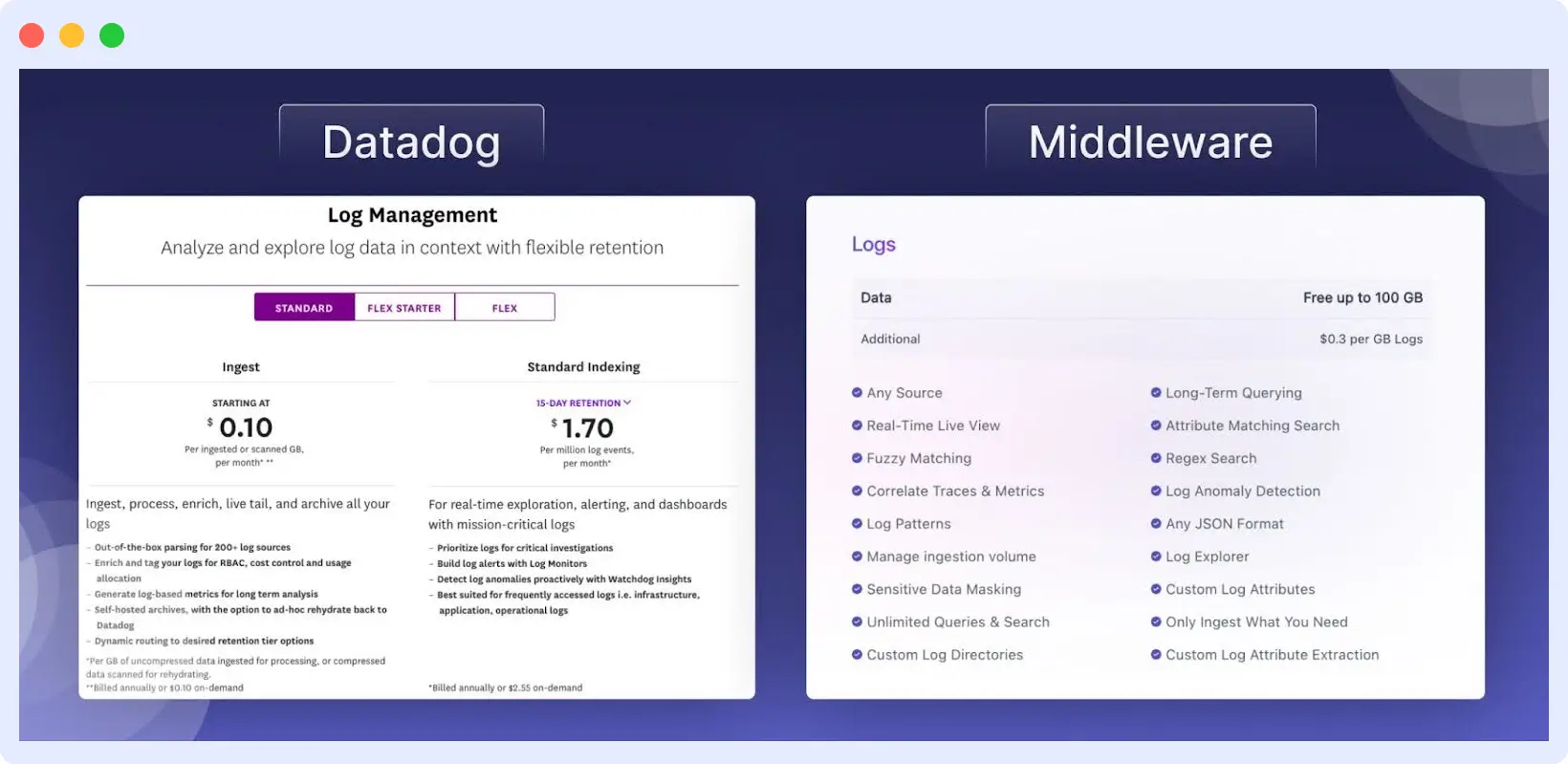
Datadog’s Log Monitoring Pricing
Datadog offers two log monitoring plans:
Ingest Plan:
- Real-time ingestion and processing
- Priced at $0.10 per GB/month (uncompressed or scanned)
- Suitable for real-time enrichment and structuring
Standard Indexing Plan:
- Simplified pricing based on event volume and retention
- $1.06 per million log events/month (billed annually) or $1.59 on-demand
- Includes pattern detection, analytics, and discovering trends.
💡 Expert Tip: “Before ingesting logs into Datadog, set volume caps or filters teams often underestimate how quickly log storage costs grow.”
Downside:
Datadog’s backend ingests and processes log data at a fee per GB. Teams with high log volumes can lead to unexpected cost bubbles, especially if there is no control around log volume.
Middleware Log Monitoring Pricing
Middleware offers a usage-based and transparent approach.
We have the following pricing plans:
- Free Tier: Ingesting at no cost up to 100 GB/month
- Pay As You Go: Price of $0.30 per GB, regardless of compression
- Enterprise: Unlimited searches, alerts, and queries
Key Features (Included in all plans):
- Live view + real-time ingestion
- Regex, fuzzy, and attribute-based search
- AI-based anomaly detection
- Support of custom log attributes & JSON formatting
- Log patterns + sensitive data masking
- Full correlation with traces and metrics
Middleware enables teams to manage ingestion volume with fine-grained controls, mitigating the risk of overpaying for unused data and/or excessive data ingestion. You only pay for what you consume. No high-watermark billing and no indexing overhead.
Datadog vs Middleware Log Monitoring Pricing Comparison
| Feature | Datadog | Middleware |
| Free Tier | Limited | 100 GB/month |
| Base Pricing | $0.10/GB (Ingest) | $0.30/GB |
| Indexing Costs | $1.06–$1.59/M log events | Included |
| Search & Alerts | Paid add-ons in some plans | Unlimited |
| Pricing Model | Volume-based, high variability | Predictable, usage-based |
Application Performance Monitoring (APM)
Both Datadog and Middleware offer powerful APM tools that deliver end-to-end visibility into application performance. These solutions help engineering teams identify root causes through code-level distributed tracing and optimize system behavior across services.
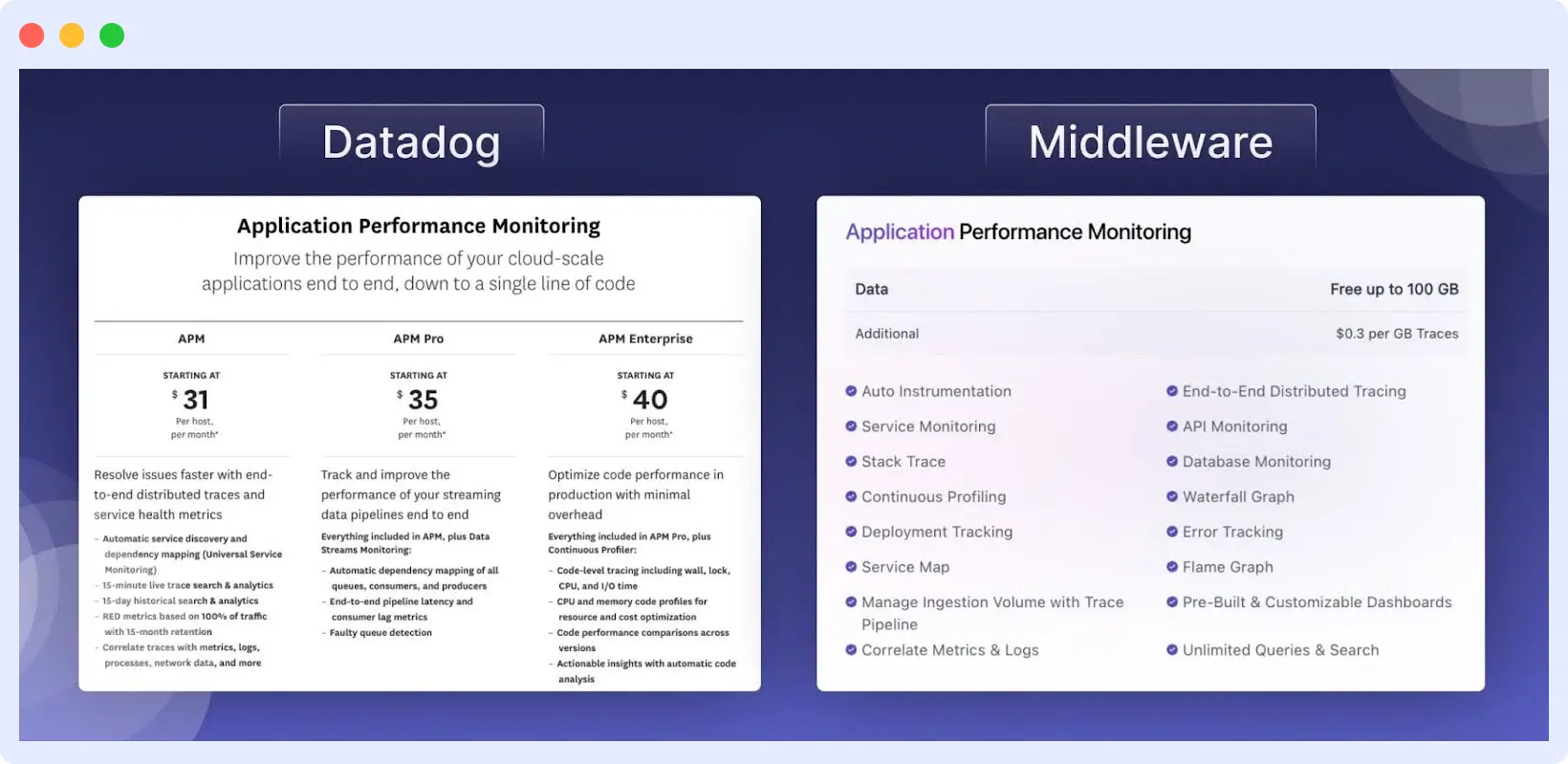
Datadog’s APM Pricing
Datadog offers three pricing models for its Application Performance Monitoring (APM) solution:
- APM starts at $31 per host per month, providing end-to-end distributed traces, service health metrics, and automatic service discovery.
- APM Pro starts at $35 per host per month, including everything in APM plus data stream monitoring for tracking and improving streaming data pipelines.
- APM Enterprise starts at $40 per host per month, featuring a Continuous Profiler that optimizes code performance in production with code-level tracing and actionable insights.
Important note: All APM plans require a corresponding Infrastructure Pro or Enterprise plan, which increases total cost. For teams monitoring many hosts, these costs can add up quickly.
Middleware’s APM Pricing
Middleware offers a usage-based APM pricing model with no host-based billing:
- Free Tier – 100 GB/month of APM data
- Post-Free Tier – $0.30 per additional GB
- Full feature access regardless of data volume or usage
Included APM Features
- Code-level distributed tracing
- Root cause detection and correlation with logs and metrics
- Unlimited span search
- Supports modern frameworks and microservices
No hidden dependencies: Unlike Datadog, Middleware’s APM doesn’t require bundling with an infrastructure monitoring plan. Everything is included under one flexible pricing model.
Datadog vs Middleware APM Pricing Comparison
| Feature | Datadog | Middleware |
| Pricing Model | Per host/month (tiered) | Per GB (usage-based) |
| Base APM Cost | $31–$40/host | $0.30/GB |
| Infrastructure Dependency | Required | Not required |
| Free Tier | Limited | 100 GB |
| Tracing and Profiling | Available in higher tiers | Included |
| Scalability | Cost increases with host count | Scales with actual usage |
Middleware offers a flexible and cost-efficient APM solution that eliminates the overhead of host-based billing while providing the full range of observability features. For scaling teams or startups, Middleware offers a more sustainable option without compromising on performance insights.
Real User Monitoring (RUM)
Real User Monitoring (RUM) enables teams to track how actual users interact with their applications in real-time. It plays a critical role in identifying UI bottlenecks, tracking performance metrics, and debugging issues in web and mobile applications.
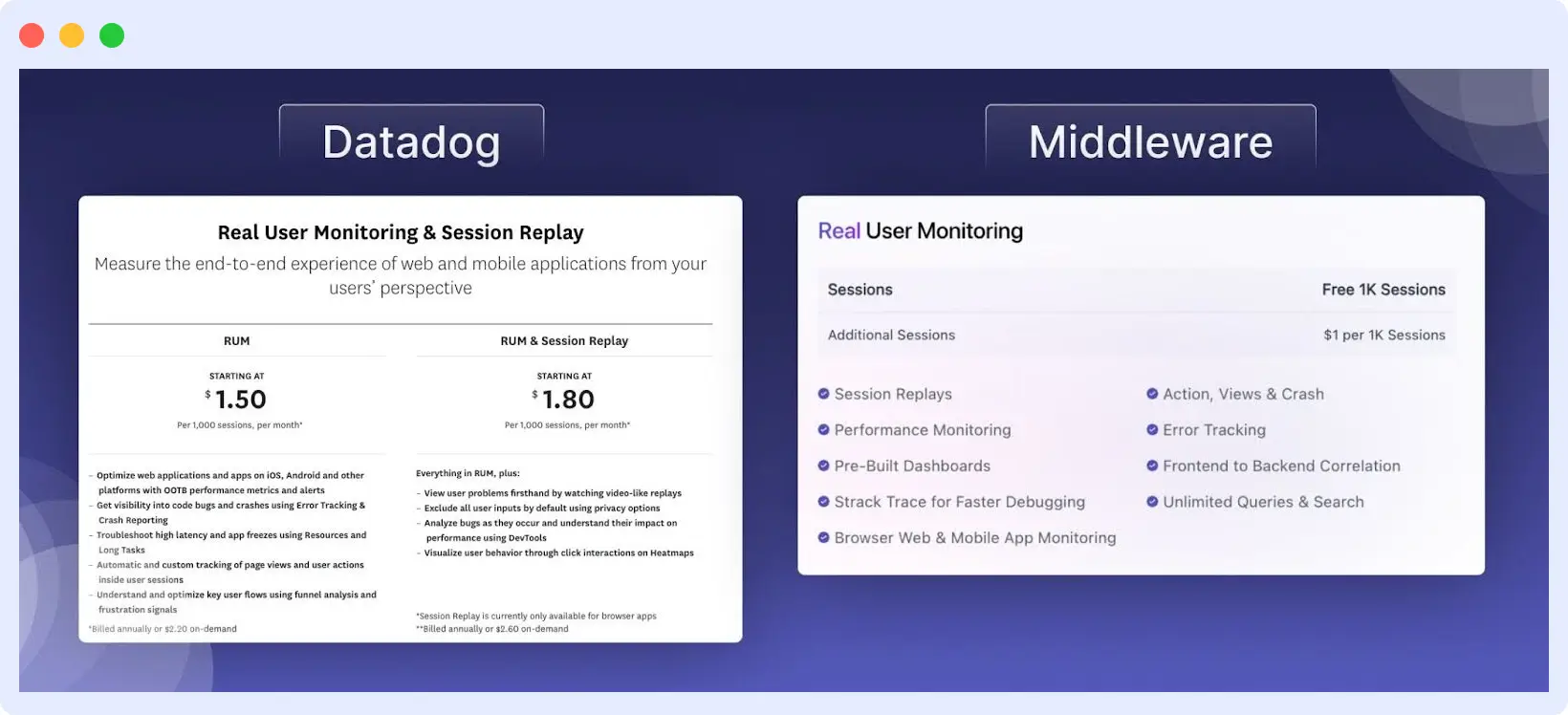
Datadog’s RUM Pricing
Datadog offers two primary RUM plans:
RUM Basic:
- Starts at $1.50 per 1,000 sessions/month (billed annually) or $2.20 on-demand.
- Includes user experience tracking for web and mobile apps, performance metrics, alerting, error tracking, and crash reporting.
RUM + Session Replay:
- Starts at $1.80 per 1,000 sessions/month (billed annually) or $2.60 on-demand.
- Adds session replays (currently only for browser apps), heatmaps, bug analysis tools, and advanced privacy controls.
While feature-rich, Datadog’s RUM plans can become costly for applications with high user volumes or frequent usage spikes.
Middleware RUM Pricing
Middleware simplifies RUM pricing with a usage-based model:
- Free Tier: 1,000 sessions/month
- Pay As You Go: $1 per additional 1,000 sessions/month
- No annual contracts or on-demand rate hikes
Included Features:
- Session replays
- Error tracking and stack trace diagnostics
- Frontend-to-backend correlation
- Performance dashboards
- Browser, web, and mobile monitoring
- Unlimited queries and searches
Middleware offers the same core RUM functionality as Datadog, without requiring tiered upgrades or session replay limitations.
Datadog vs Middleware RUM Pricing Comparison
| Feature | Datadog | Middleware |
| Base Pricing | $1.50–$2.60 per 1K sessions | $1 per 1K sessions |
| Free Tier | Not available | 1,000 sessions |
| Session Replay Support | Browser apps only (higher plan) | Browser, web, and mobile |
| Billing Type | Annual/on-demand | Pay-as-you-go |
| Debug Tools | Included with higher plans | Included in base pricing |
Middleware offers a more straightforward and more cost-effective RUM solution for teams of all sizes. With a generous free tier, flat pricing, and full access to session replays and diagnostics, it’s a strong choice for modern performance monitoring.
Infrastructure Monitoring
Infrastructure monitoring involves monitoring the health, performance, and availability of your IT infrastructure components, such as servers, networks, databases, and applications.

Datadog’s Infrastructure Monitoring Pricing
Datadog’s Infrastructure monitoring offers a range of pricing plans to suit different needs.
- The free plan includes core collection and visualization features, 1-day metric retention, and support for up to 5 hosts.
- The Pro plan starts at $15 per host per month (billed annually) and offers additional features like 750+ integrations, out-of-the-box dashboards, and 15-month metric retention.
- The Enterprise plan starts at $23 per host per month (billed annually) and includes advanced features like machine learning-based alerts and live processes.
- Additionally, Datadog offers two DevSecOps plans, Pro and Enterprise, which include features like continuous scanning for misconfigurations, vulnerability management, and compliance frameworks, starting at $22 and $34 per host per month (billed annually).
Middleware’s Infrastructure Monitoring Pricing
- Middleware’s Infrastructure monitoring offers a free tier of up to 100 GB, making it an attractive option for small to medium-sized businesses.
- For additional data, the pricing is $0.3 per GB, providing a cost-effective solution for larger enterprises. Middleware’s infrastructure monitoring capabilities include container monitoring, service monitoring, and Kubernetes monitoring.
- The flexible pricing model allows businesses to ingest only what they need, with metric-level and attribute-based controls for Kubernetes ingestion, making it a scalable and affordable choice for infrastructure monitoring needs.
Datadog vs Middleware Infra Monitoring Pricing Comparison
| Feature | Datadog | Middleware |
| Base Pricing | $15–$23 per host/month (annual) | $0.30 per GB |
| Free Tier | 5 hosts, 1-day metric retention | 100 GB/month |
| Container/Kubernetes Support | Yes (higher plans) | Yes (included) |
| Machine Learning Alerts | Enterprise only | Available with real-time monitoring |
| Billing Model | Host-based | Usage-based |
Datadog provides extensive infrastructure monitoring with long-term retention and ML-powered features, but at a premium price. Middleware offers a more scalable, budget-friendly option for teams looking to monitor containerized or cloud-native infrastructure without per-host limitations.
Synthetic Monitoring
Synthetic monitoring involves simulating user interactions with applications or websites to monitor their performance and availability. It helps businesses proactively identify issues, optimize user experiences, and ensure the reliable delivery of applications.
Datadog’s Synthetic Monitoring Pricing
Datadog’s Synthetic Monitoring pricing offers a tiered structure across API, Browser, and Mobile App Testing.
- API Testing starts at $5 per 10,000 test runs per month
- Browser Testing at $12 per 1,000 test runs per month
- Mobile App Testing at $50 per 100 test runs per month.
Additional parallelization for Continuous Testing is available as an add-on starting at $79 per month.
Datadog offers discounts for annual billing, while on-demand pricing is higher. Though flexible, these plans can become expensive for teams running large-scale synthetic tests regularly.
Middleware’s Synthetic Monitoring Pricing
Middleware’s synthetic monitoring pricing includes 20,000 checks free, with additional checks charged at $1 per 5,000 checks. This offers a more cost-effective solution for teams with a large number of tests. Middleware’s synthetic monitoring capabilities include API and multi-step API testing.
Its pricing and simplicity make Middleware a compelling option for continuous testing without incurring high operational costs.
Datadog vs Middleware Synthetic Monitoring Pricing Comparison
| Feature | Datadog | Middleware |
| API Test Pricing | $5 per 10,000 runs | $1 per 5,000 checks |
| Browser Test Pricing | $12 per 1,000 runs | Included in check limits |
| Mobile App Test Pricing | $50 per 100 runs | Not specified (API-focused) |
| Free Tier | None | 20,000 checks/month |
| Continuous Testing Add-on | $79/month | Included |
| Billing Model | Tiered by test type | Unified pay-as-you-go |
Datadog offers detailed test types and parallelization options, but at a significantly higher cost. Middleware provides a simple, unified, and affordable alternative ideal for scaling synthetic monitoring without pricing headaches. It includes API and multi-step API testing.
Custom Metrics Pricing
Custom metrics allow engineering teams to extract key signals from log data and trace performance across specific dimensions. They play a crucial role in optimizing applications and infrastructure visibility.
Datadog Custom Metric Pricing
Datadog charges for custom metrics based on a complex calculation:
- A custom metric is defined by the metric name plus all associated tag combinations (e.g., api.response_time{region:us-east, env:prod}).
- Each unique combination of name and tags is treated as a separate custom metric.
- Billing is based on the average hourly count of unique custom metrics across the month.
- This total is then divided by the number of hours in the month to calculate the monthly billable usage.
This structure often leads to unexpected charges, especially in environments with dynamic tags or frequent deployments.
Middleware’s Pricing
Middleware takes a simpler and more predictable approach:
- Custom metrics are free with no caps or hourly tracking.
- Users can build dashboards using both infrastructure metrics and custom log-derived metrics at no extra cost.
- Features include metric-level ingestion control, helping teams reduce noise and prioritize high-value data.
This transparency makes Middleware especially attractive for teams that rely heavily on tagging or dynamic metric creation.
Datadog v/s Middleware
Here’s a side-by-side comparison of Datadog v/s Middleware based on key factors:

Datadog’s pricing is powerful but opaque, often resulting in bill shock when metrics scale rapidly or tagging strategies expand.
Middleware offers unlimited custom metrics for free, giving teams the freedom to monitor what matters most without budget constraints.
If you’re looking to avoid unexpected metric costs and value predictable billing, Middleware provides a simpler, scalable alternative to Datadog’s complex custom metric pricing model.
Now that we’ve broken down each feature’s pricing, let’s look at what these numbers actually mean in real-world scenarios.
💰 Want to know how much you could save?
Use Middleware’s transparent pricing to estimate your exact monthly cost — no surprises.
🔍 Check Your Savings Now
Real-World Datadog Pricing Scenarios (Based on Public Estimates)
To understand how Datadog’s pricing can scale in real-world enterprise environments, let’s examine a combined scenario across common observability workloads.
Scenario: 100 TB Data Ingestion, 100 Hosts, and Full-Stack Monitoring
Let’s assume a mid-sized enterprise with the following infrastructure setup:
- 100 TB of data ingested per month (logs, metrics, traces)
- 100 hosts running both Infrastructure Monitoring and APM
- 1 million RUM sessions per month
- 500,000 Synthetic API Tests
- 100,000 Browser Synthetic Tests per month
- Standard 30-day data retention
Datadog Pricing Breakdown
| Component | Metric | Unit Price | Estimated Monthly Cost |
| Infrastructure Monitoring (Pro) | 100 hosts × $18/host | $18 | $1,800 |
| APM (Standard) | 100 hosts × $36/host | $36 | $3,600 |
| Logs Ingestion | 100,000 GB × $0.10/GB | $0.10 | $10,000 |
| Log Indexing (30-day retention) | ~Based on $2.55/1 M events (approx. 1 GB ≈ 1 M events) | $2.55 | $255,000* |
| RUM Sessions | 1 M sessions × $4.50/1,000 sessions | $4.50 | $4,500 |
| Synthetic API Tests | 500,000 API tests × $7.20/10,000 | $7.20 per 1k | $360 |
| Synthetic Browser Tests | 100,000 browser tests × $18/1,000 | $18 | $1,800 |
| Enterprise Support (~8%) | 8% of the subtotal | $22,164 |
Cost Estimate: ~ $299,225/month and $3.3 – $3.6 million per year
(Actual cost may vary depending on usage, region, and enterprise discounts.)
Middleware: A Unified Pricing Approach
In contrast, Middleware offers a simple, GB-based pricing model that includes logs, metrics, traces, APM, RUM, and synthetic monitoring, all under one unified cost, without per-host or per-feature billing.
| Component | Metric | Unit Price | Estimated Monthly Cost |
| Data Ingestion Volume (Logs + Metrics + Traces) | 100,000 GB Data × $0.30/GB | $0.30 | $30,000 |
| Infrastructure + APM | 100 Host Included in unified GB cost | 0 | Included |
| Log Indexing (30-day retention) | 100,000 GB Data | 0 | Included |
| RUM Sessions | 1 M sessions × $1/1,000 | $1 | $1,000 |
| Synthetic Tests (API + Browser) | 500,000 tests × $1/5,000 | $1 | $100 |
| Browser Tests | 100,000 × $9.99/1,000 | $9.99 | $999 |
Total Middleware Monthly Estimate: ≈ $32,099 /month
Cost Comparison Summary
| Platform | Estimated Annual Cost |
| Datadog | $3,590,700/year |
| Middleware | $385,188/year |
| Annual Savings with Middleware | ≈ $3.2M/year (~89% lower) |
💰Organizations can save approximately $3.2 million per year, nearly 89% lower than Datadog’s estimated annual cost.
Key Observations
- Pricing Model: Datadog’s host- and feature-based pricing can lead to exponential cost growth as you scale. Middleware’s GB-based model remains predictable and transparent.
- Log Management: Log ingestion and indexing are major cost drivers in Datadog. Middleware eliminates the need for separate ingestion and retention fees.
- Unified Visibility: Middleware covers APM, infrastructure, RUM, and synthetic monitoring under one plan, with no fragmented billing.
- Scalability: Middleware’s volume-based pricing scales smoothly across hosts, containers, and regions, offering long-term cost stability.
- Support: Middleware provides full enterprise-grade support without additional percentage-based charges.
For an organization managing 100 TB of data ingestion, 100 hosts, and full observability coverage:
- Datadog: ≈ $299K/month (~$3.59M/year)
- Middleware: ≈ $32K/month (~$385K/year)
That’s roughly a 6×–9× cost reduction with Middleware achieved through a unified, GB-based observability model, without sacrificing visibility, scalability, or performance.
What are the People Saying?
We looked at user reviews on G2, a trusted platform for software insights, to understand what real users think about Datadog and Middleware.
Datadog’s Review on G2
Datadog has a rating of 4.4 stars out of 5 on G2, with common feedback indicating that many users praise its powerful features but also highlight a steep learning curve and complicated billing system.
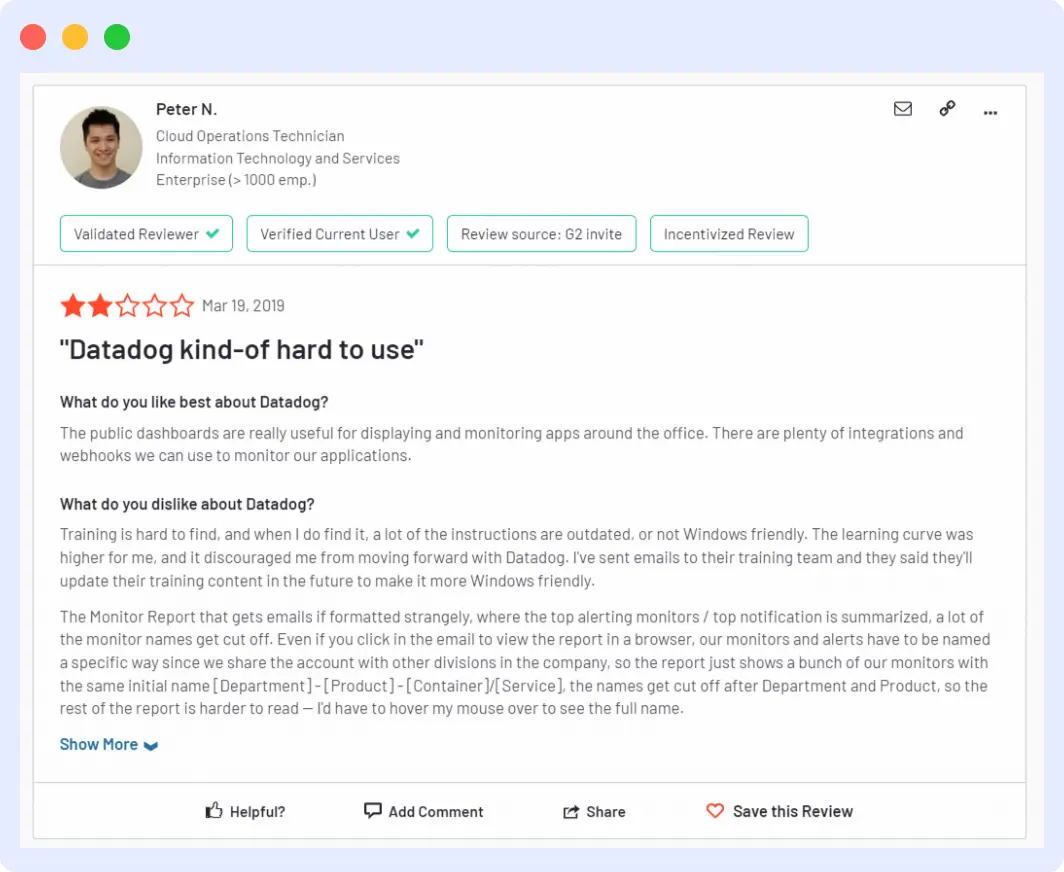
We ran into multiple configuration issues that Datadog’s support team wasn’t able to resolve quickly. At one point, we were even told to remove sources from the platform or face an account closure, which wasn’t very customer-friendly
Elijah Smith, Software Engineer III at Generation Esports
Middleware’s Review on G2
Rating: 4.5 out of 5 stars
Common Feedback: Users appreciate the transparent pricing, intuitive UI, and responsive support. Many see Middleware as a cost-effective alternative to Datadog.
The thing that immediately attracted me to Middleware was its ability to undercut Datadog in pricing. As a startup, we’re always looking for ways to reduce costs and increase efficiency, and Middleware’s pricing made a lot more sense for us.
Aaron Hawkey, Co-Founder & CTO, Generation Esports

Is Datadog’s Price Worth it in 2026?
As of 2026, evaluating the worthiness of Datadog’s pricing requires considering various factors. One aspect that is not well-received about Datadog is its billing and support system. Users have reported difficulties in resolving deployment mistakes and billing issues.
Some users have expressed frustration with the lack of support and the inability to remove metrics from agents or adjust billing accordingly. This highlights the need for better flexibility and responsiveness in addressing customer concerns.
In comparison, Middleware emerges as a potential alternative that offers a more favorable solution. With Middleware’s straightforward pricing models and user-friendly billing system, users can avoid the complications and frustrations associated with unexpected charges or difficulties in adjusting usage.
Additionally, Middleware’s specialized focus on infrastructure monitoring, synthetic monitoring, APM, and real-user monitoring ensures a targeted and efficient approach to meeting monitoring needs.
Want to see how real companies are switching? Discover how Generation Esports reduced its observability costs and improved MTTR by 75% with Middleware.
Is Datadog pricing worth it in 2026?
Datadog’s pricing is worth it only if you use limited features or have a small infrastructure footprint. For most teams in 2026, Middleware offers equivalent observability at a fraction of the cost.
What’s the best Datadog alternative?
Middleware, with pay-as-you-go pricing, free 100GB tier, and full feature access without host-based charges.
How does Middleware billing differ from Datadog?
Datadog uses high-watermark pricing and requires tier upgrades. Middleware charges only for real usage with no spikes.
Why is Datadog pricing so high in 2026?
Because Datadog uses a host-based and high-watermark billing system, your costs can rise even during short usage spikes.
How can I estimate Datadog costs more accurately?
Use Datadog’s pricing calculator, factor in add-ons like APM, RUM, and custom metrics, and monitor monthly host count variations.
